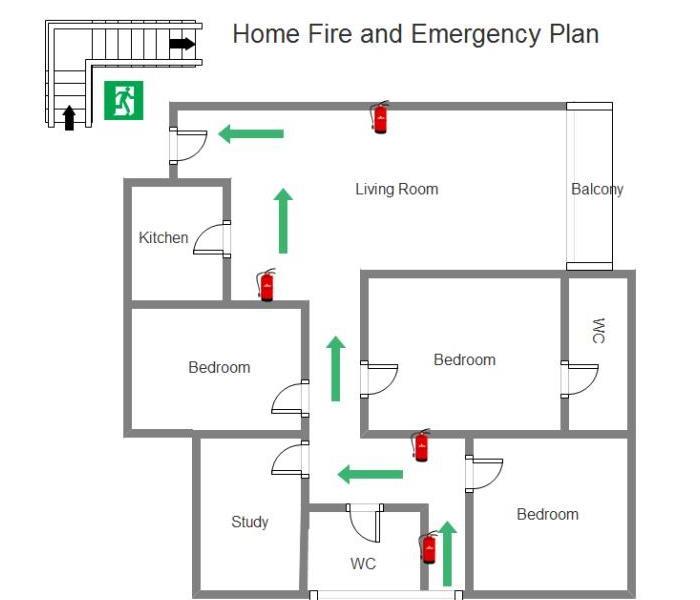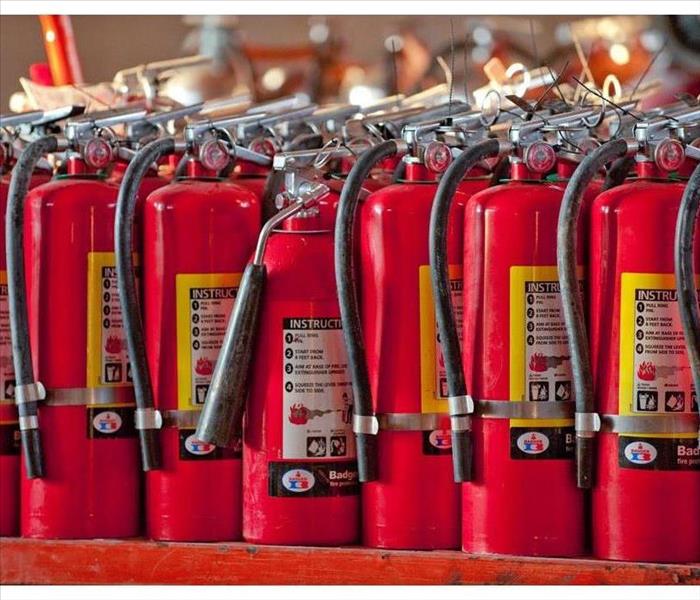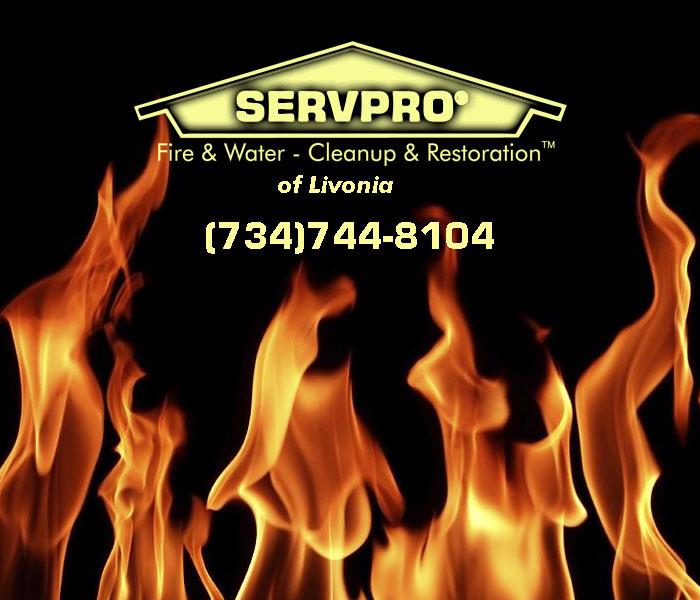Archived Fire Damage Blog Posts
Firework Disposal
7/8/2021 (Permalink)
We hope everyone had a fun and safe celebration for their 4th of July gathering. With Independence Day now over, you may have some left-over fireworks. It is important to take note of safe handling and proper storage of any unused fireworks. The brands, types and styles may all be different and unique. You should always follow the directions listed on the manufactures label. Unused fireworks can pose a fire danger to your home, garage, shed, outbuildings, etc. if not properly stored or discarded in a safe manner. Fireworks can ignite or detonate from their environment by means such as static electricity or a sharp blow (force). The State of Michigan offers some safety tips on proper disposal of unused fireworks if you do not have the storage area to properly store them. https://www.michigan.gov/mienvironment/0,9349,7-385-90161-562917--y_2020,00.html
Please take a moment to educate yourself on these simple steps to help prevent a fire hazard in and around your home.
Fire up the grill NOT your home
5/23/2021 (Permalink)
 Grill House Fire Damage
Grill House Fire Damage
Those of us who enjoy a delicious meal cooked outdoors, it is that time of year. Knowing a few safety tips can keep your meal time a good one and help prevent a house fire.
There are many methods for cooking outside such as Gas grill, charcoal grill, smoker and hibachi to name a few. Each method comes with it’s own safety recommendations. It is important to read the proper use and safety tips that come with it.
To help prevent catching your home on fire and staying safe while cooking here are a few tips:
Place your grill a safe distance from your home
Never leave your grill unattended
Keep a fire extinguisher on hand
Keep children at a safe distance
Only use the proper starter fluid or ignition method to ignite the flame
Clean your grill before and after use
Posting these few tips near where you grill can serve as a reminder to grill safely.
Dorm Safety
1/5/2018 (Permalink)
As college students head back to their dorm after winter break, remember these tips to stay safe and keep those around you safe.
Learn the building’s evacuation plan.
If you’re living on campus, chances are your dorm will have an emergency evacuation plan and all buildings on campus should have an evacuation plan posted on each floor. Make sure you are familiar with these plans.
If you live off campus, have an escape plan of your own with at least two ways out of each room.
Don’t overload your room’s electrical outlets.
Most electrical outlets in dorms are designed to handle specific amperage. It’s best not to try to push them to their capacity by using too many multi-plug devices. If you ever notice any scorched marks or burning odors around an electrical outlet, stop using that outlet and inform someone of the problem right away.
Cook with care.
Be careful when cooking in your dorm or in the dorm’s community kitchen. If you do not have a kitchen in your dorm, then you should follow the school’s guidelines on what sort of plug-in cooking equipment is permitted for use in the dorms. Always be careful with electric frying pans, toasters, toaster ovens, microwaves, etc. Never leave your dorm when cooking appliances are in use.
Respect open flame policies.
Most schools don’t allow you to smoke or burn candles or incense in the dorms. If you do smoke, be sure to do so in the designated areas on campus (most likely away from buildings). Avoid burning candles or incense in your dorm room. If you burn them for the smell, try using essential oil diffusers to create a pleasant aroma in the dorm. If you do still choose to burn candles or incense in your dorm, never leave them unattended and keep them away from flammable materials.
Don’t tamper with fire safety features in your dorm.
Most dorms should have smoke detectors. It is important that you do not cover them with any decorations in your dorm. Additionally, do not remove the batteries in your dorm’s smoke detector. It will send a signal to Public Safety to investigate the source of the problem. If your dorm has a sprinkler system in place, don’t hang any decorations on it. Sprinklers are there to help put out a fire before firefighters can get there. They are especially important if your dorm is on an upper level as it can be more difficult for firefighters to get to the flames.
Be mindful of clutter and how you decorate your dorm.
While decorating a dorm room can display your personality or bring some of home to school with you, it can also become potential fuel for a fire. Every poster or tapestry you hang on the wall, or piece of decor you hang from the ceiling, can be considered a fire hazard. Some schools may limit the amount of wall space that can be covered in your dorm, or may prohibit hanging things from the ceiling. Even if there are no restrictions, it would be wise to limit the amount of decor you hang in your room as well as to keep clutter to a minimum. Additionally, avoid draping materials over hot items like lamps that could potentially cause ignition. Furniture should also be kept away from the room’s heat source to reduce the risk of fire.
5 Things to Include in Your Fire Escape Plan:
1/4/2018 (Permalink)
- Draw a Map of Your Home.
Draw a map of each level of your home. On your map make sure to show the following:
- All doors,windows, & smoke alarms.
- 2 ways to get out of each room. Check to make sure you can open all doors and windows easily.
- Mark a safe location to meet near the front of your home.
- Have 2 Ways Out of Each Room.
When making your plan try and have at least 2 ways out of each room. Also, make sure each person can open all the windows and doors.
- Know How to Keep Yourself Safe When Escaping!
There are multiple different scenarios that can happen when you’re trying to get out of your home, so make sure you and your family know how to handle them.
A few things to know and practice are:
- Crawling low to the floor to avoid toxic smoke.
- Closing doors on your way out to help slow the spread of fire, giving more time to safely escape.
- Stop, Drop, & Roll if clothes catch on fire.
- How to call 9-1-1 to get help.
If the fire prevents you from escaping, here are some tips…
- Use duct tape or towels to seal the door cracks and cover air vents to help keep smoke from coming in.
- Call for help, or if you don’t have a phone try using a whistle to alert neighbors.
- Wave a flashlight or light-colored cloth at the window to let the fire department know where you are located.
- Get Out & Stay Out!
Designate a meeting location a safe distance in front of your home – like at the end of the driveway, on the sidewalk, or near a certain tree. You want it to be near the front of your home so the firefighters will know that you’re out.
Be sure to never go back into a burning building for any reason! If someone is missing tell the firefighters right away since they are equipped to perform rescues safely.
- Have a Fire Drill Twice a Year!
Fire drills aren’t just for schools, but for your home too!
It is recommended that youprepare and practice your fire escape plan twice a year with everyone in your household, including children.
Oven Fires
12/18/2017 (Permalink)
Oven Fire
Here at SERVPRO Livonia we had a call come from a house fire due to an oven malfunction.
If you have never experienced an oven fire, here are some tips on how to handle this emergency situation.
- Leave the oven door closed.
- Turn off the oven and allow the fire to burn out on its own.
- If it does not go out on its own, leave the house and call 911.
- If it does go out, then open your windows.
- Carefully open the oven door after ½ an hour has passed.
- Allow the smoke to clear before determining the cause of the fire and possibly resuming cooking.
Although Step 1 may seem incorrect, opening the door will only cause the fire to expand. By keeping the door closed and turning off the heat, you are starving the fire, since it can’t burn without oxygen.
Fireplace Tips and Safety
12/14/2017 (Permalink)
Enjoying a warm, cozy fire requires a clean, safe fireplace. Here are some tips for keeping it that way:
- Fireplaces should not be used as furnaces. Use a fireplace for a short-duration fire — no longer than five hours.
- Keep the glass open to allow air to be drawn up to cool the chimney, but keep the screen closed to prevent sparks from jumping onto the carpeting.
- Never leave a fire unattended when children are in the house. Adults, even if near, should not allow children to play near or with fire tools and equipment.
- Open a window when using the fireplace to prevent the room from becoming smoky. The air coming in from the window will go up the chimney.
- Before making a fire, open the glass doors, pull aside the screen curtains, and place the kindling, newspaper and logs inside. Next, open the damper and a window. The window needs to be open only a few inches. You can check to make sure the smoke will go up the chimney properly by lighting a match, quickly blowing it out and watching the smoke to see whether it's going up and out.
- Keep a nonflammable rug (available at fireplace-supply stores) in front of the fireplace so that sparks won't melt or otherwise damage your carpeting.
- Use fireplace tools to handle burning logs. Never use your hands.
- Use a chimney cap to prevent water damage, to keep animals from nesting and to keep debris from blocking the chimney and causing carbon monoxide to flow into the house. Use a spark arrester to help prevent sparks from flying out, which could start a fire on the roof or lawn.
- Glass doors may develop tough stains from flames and heat. To clean them, make sure the glass doors are cool, then scrape off any thick gunk deposits with a razor blade. Add a squirt of liquid dishwashing detergent to a bucket of warm water, or add a cup of vinegar to a gallon of water. Spray or sponge the cleaner on, and then wipe it away with newspaper (which is lint-free). Another option is to buy glass cleaner at a fireplace store.
- Fireplace coals can remain hot enough to start a fire for up to three days, so always wait at least that long before removing the ashes. At that point, close the damper to prevent cold air in the flue from stirring up excess dust while you're removing the ashes. Be sure to wear a dust mask and open a window in the same room as the fireplace to prevent negative air pressure. Use a shovel to scoop the ashes into a metal container. Store the container far from combustible materials and surfaces and wood floors.
- Never use a vacuum to clean up ashes, because live coals may remain in those ashes.
- Have a certified chimney sweep inspect and clean the chimney when necessary. Have him show you how to check it yourself, too. The chimney should be checked at least once a year or after about 80 fires.
- Shine brass fireplace utensils with Worcestershire sauce and a toothbrush.
- Clean the firebox (the area where the logs burn) at least once a week during the months you use it, when ash builds up. Leave about an inch of ash because it acts as insulation, allowing the coals to heat faster and retain the heat easier. Keep the firebox completely clean during the months when the fireplace is not in use.
- To clean an exterior slate hearth, wash, dry and coat it with lemon oil every six weeks to make it shine. For cleaning exterior brick hearths, buy a brick cleaner at a fireplace shop.
Tips from HGTV.com
Fire Extinguisher in the Home
12/13/2017 (Permalink)
It is recommended that two fire extinguishers be on every floor in a home.
Every household extinguisher is labeled A, B, or C, which tells you the types of fires the extinguisher is effective against. A is ordinary combustibles like wood, paper, and cloth; B is flammable liquids, such as gasoline or cooking oil; and C is live electricity.
ABC Fire Extinguishers, use monoammonium phosphate which is a dry chemical that is able to quickly put out the fire. It is a pale yellow powder that is able to put out all three classes of fire; Class A for trash, wood and paper, Class B for liquids and gases, and Class C for energized electrical sources.
To use a fire extinguisher, remember PASS:
- Pull the pin.
- Aim the nozzle at the base of the fire. Hitting the tops of the flame with the extinguisher won't be effective. ...
- Squeeze the trigger. In a controlled manner, squeeze the trigger to release the agent.
- Sweep from side to side. Sweep the nozzle from side to side until the fire is put out.
Emergency Fire Tips
9/29/2016 (Permalink)
There are many do's and don'ts for emergency damage situations. One of the hardest parts of dealing with the aftermath of a fire, is the desire to start cleaning and getting everything back in order. It's very important to NOT start cleaning. In an effort to straighten everything out, you may actually cause further damage. Here are a few do's that you can do. Keep your hands clean and limit movement in the home to prevent further damage. Place dry colorfast towels or old linens on carpeted traffic areas to prevent more soiling. If the electricity is turned off, empty freezers and refrigerators. You are able to wipe soot from chrome on faucets and appliances, but do not clean any appliance that was near the fire without consulting an expert first. SERVPRO of Livonia is dedicated to helping you recover from your fire loss.

 24/7 Emergency Service
24/7 Emergency Service




